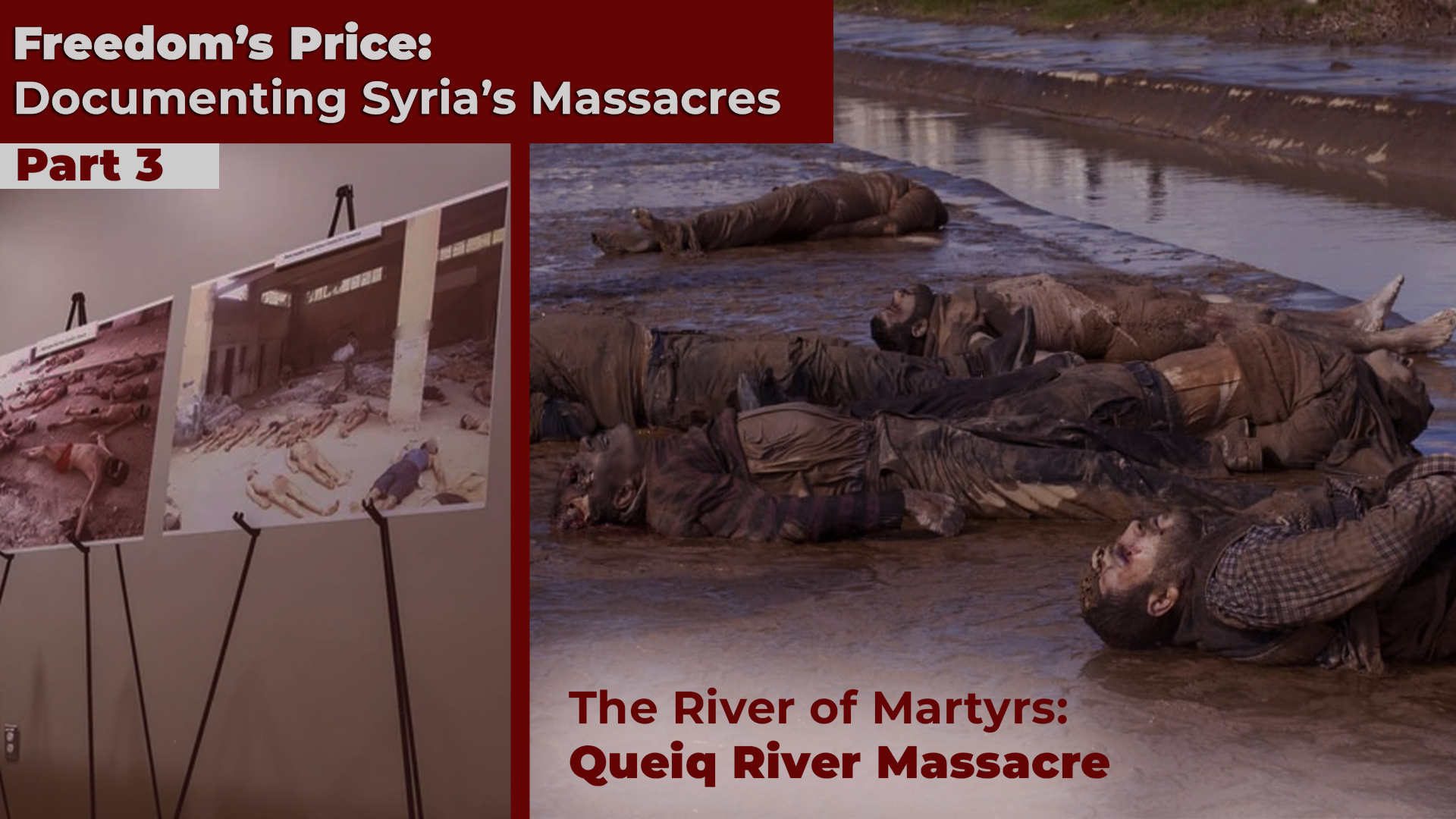The River of Martyrs: Queiq River Massacre

Freedom’s Price is a series of articles aiming to shed light on the major massacres that have occurred during the ongoing conflict in Syria over the last 13 years. Each article highlights the crimes the Syrian people have endured in the course of their revolution and the high cost in their struggle for freedom and dignity. This installment in the series L24 looks at the 90 days that rocked eastern Aleppo at the beginning of 2013 as nearly 20-30 bodies began to appear daily in the Queiq River.
It was January 29, 2013, when a legal clerk with the prosecutor’s office, Muhammad al-Halabi, received a message from a judge, “There are bodies at Queiq River, go and see what’s going on.” Muhammad arrived at the scene accompanied by a judge, the pair came upon a gruesome scene, bodies, some bloated and bloody, hands bound behind their backs with taped mouths were being fished from the frigid waters and lined up on the muddy bank. Al-Halabi wondered who they were and how they came to be here, what was going on, who killed them, who had done this? He was questioning those gathered trying to find answers when he heard, “There are more bodies!” It was then the clerk spied more corpses floating down the river from the Assad-regime side of the downstream to their home in the liberated eastern part of Aleppo.
The events that unfolded in late January 2013 in the liberated part of eastern Aleppo were nothing short of harrowing. After 22 months of brutal retaliation by the Assad regime against government reform protesters, the Queiq River became the haunting site where the bodies of approximately 110 men and boys, bearing gunshot wounds to the head, were discovered. The advent of Spring would bring with it an additional 120 bodies, all retrieved from the river. By mid-March 2013, the officials installed a grate into the river to catch the bodies. The situation was so dire that the local authorities made the heartbreaking decision to reduce the river’s water level in an attempt to spare the people’s daily task of retrieving bodies. This tragic chapter has led the Queiq River to become known as “The River of Martyrs,” a stark reminder of the tyranny of Assad and the absence of justice.
Documenting the Dead
Following the morbid discovery, the work shifted from collecting corpses to collecting data and documenting the dead. “The bodies were transferred from the Queiq River to (Yarmouk) school in Bustan Al-Qasr,” al-Halabi told L24.

Al-Halabi had been sent to the school where he was told to count the number of dead, he explained the pandemonium in the makeshift morgue, “One shouts, ‘My mother!’ Another one, ‘This is my brother! This is my father!’ Somebody is crying, someone asks, ‘Does anybody know him?’ and ‘This one has no relatives, put him aside.’ It was madness.”
Doctor Muhammad Keheel, who took part in the examination and documentation of the deceased, observed that the majority of the victims were between 20 and 40 years old and that many had been killed shortly before being dumped into the river, still clothed, with close-range gunshot wounds to the head resulting in shattered skulls. Almost all had their mouths taped, and their hands, and sometimes feet, bound.
In 2013, the Queiq River divided Aleppo City into two parts: the western under the Assad regime’s control and the liberated eastern side, administered by a coalition of mainly Free Syrian Army (FSA) revolutionary bodies. The river acted as a natural line of demarcation, with regime forces in the northwest and revolutionary forces in the southeast. This division had remained relatively stable since July 2012.
As military confrontations eased, many civilians in the city returned home and felt safer to resume activism in the liberated areas. While others, workers and small business owners crossed daily between the opposing areas, some lived in one part of the city with shops or small bossiness in the other. However, the FSA’s establishment of an alternative governing body in the eastern part of Aleppo was seen as a threat by the Assad regime that needed to be removed.
According to a June 2013 Human Rights Watch (HRW) report a forensic expert who examined over 120 bodies, noted that the gunshot wounds had significantly disfigured the victims, making identification difficult. It was also mentioned that many bore signs of torture consistent with burns or electrocution before being killed. Despite local efforts, many bodies were too decomposed to be recognized and were buried anonymously, before which, samples were collected and stored for future DNA identification.
True Terrorism
L24 spoke to Yasin Hilal, a lawyer and witness of the Queiq massacre, who worked as a human rights activist at the time. He participated in collecting, documenting, and burying the bodies of the victims, as well as gathering evidence and information about the killings. His role was integral to the documentation team during the River Massacre.

“It spread terror among the people,” he told L24, “everyone had people inside that were against the regime, so they were afraid for their families. The reaction was very bad. We knew that this execution program was to spread terror and to displace us from Aleppo.”
“People died psychologically,” recounts al-Halabi, “I couldn’t eat or drink for three days. …It affected society. It destroyed Aleppo. Bodies kept coming into the areas from the regime for 20 or 30 days. Everybody knew somebody who had been arrested. Who had been martyred. Who had been missing. They would go and sit by the river and wait. Maybe they would find the corpse of their missing between the dead who came from the river. Aleppo was all destroyed.”
Identifying the Murders
HRW found at least 147 people whose bodies were found in the city of Aleppo’s River between January and March 2013, were most likely executed in Assad-controlled areas. The report attributes its findings to on-site investigations and interviews with the families of the over 60 identified victims, extensive video and photographic documentation, and forensic medical reports revealing evidence of torture and detainment conducive to previously utilized practices of the Assad regime security and intelligence services.
Ole Solvang, emergencies researcher at HRW said, “It’s hard to see how 147 people could have been executed and their bodies flung in the river in Assad-controlled territory, as the evidence indicates, without the knowledge of government forces operating in the area.”
Assad’s Allegations
Yet, however improbable others might think it, the regime would allege that the massacre was the work of “terrorists.” On January 30, following the discovery of the first bodies, outlets close to the regime reported that letters had been sent to the UN Security Council and Secretary General accusing Jabhah al-Nusra (JN) of committing the massacre.
In February 2020 a report by Khaled Iskef, Director of the UAE-based Syrian Center for Strategic Studies and Research (SCSSR), cited “new evidence” among which was a program by the Iran and Hezbollah-linked, Al Mayadeen network, alleging the massacre was the result of a dispute between FSA battalions. The Al Omran Battalion, led by Abu al-Baraa Nahlawi, and the Ahfad al-Rasul Battalion, led by Ahmad Shamma.

He later affirms that no less than six “anti-government military groups” were responsible for the massacre, writing, “the following list names those accused of the massacre: Nimir Battalion of Ahfad al-Rasul (FSA) and its leader Ahmad Shamma, Suyuf Halab Battalion (FSA), Al Omran Battalion (FSA), Qom Fastaqem Gathering, JN, and Usud al-Islam of Jaysh al-Islam led by Mohammad Sandeh.”
According to Iskef the feuding “rebels” massacred the victims as a result of internal disputes, despite evidence the majority of victims had no ties to any military groups and disappeared after entering Assad-controlled parts of the city. He also maintains that the victims were killed upstream in the “opposition-held” part of the city before being dumped in the river.
In Western Aleppo, under the control of the Assad regime, they installed four major Mukhabarat branches in the western part of the city. These branches, along with other detachments in the big neighborhoods and the countryside, were responsible for routine arrests and disappearances of civilians at checkpoints. The goal was to control the population and enact a campaign of coercion and domination. As a result, daily workers, owners of small businesses, and teachers were being snatched while passing by checkpoints or crossing in and out of regime-controlled areas.
The regime believed that those who were “outside the state’s control should not have the peace of mind and be treated with human decency. Rather, they have to suffer or they help the government exterminate the rebels.” The situation was dire, and the people of Aleppo were living in constant fear of being arrested or disappearing without a trace. It didn’t matter if they were civilians as, according to a former healthcare worker in Aleppo, Houthaifa Dhman, the regime believed, “it is not only the ‘terrorists’ that should be punished, but also their popular incubators.” Hence the abduction, torture, and murder of civilians became common.
HRW notes, however, that, “while it is theoretically possible that the bodies were dumped in the river on the opposition-side of the dividing line, HRW’s investigation found this to be unlikely. Residents told HRW that the area north of the bridge was not accessible because it was within range of government snipers.”
Thomas Rassloff, a Germany-based freelance photographer, who was in Aleppo at the time recounts, “I photographed the scene at the river for approximately 30 minutes before my driver felt we should leave due to the risk of (regime) snipers and mortars.” Making the feasibility of safely dumping hundreds of bodies over the course of three months improbable. Furthermore, many locals said that they had spotted bodies in the river north of the bridge, even closer to the dividing line, on several occasions, but that they had not been able to recover them until they floated further downstream due to regime snipers.
Lost in Western Aleppo
Multiple victims were last seen in, or leaving to, the western Assad-controlled side of Aleppo. Many were merchants whose homes were in the liberated area but owned businesses in the Assad-controlled side. Their bodies were discovered in the free section of Southeast Aleppo after floating downstream from the Assad-held area.
Seventeen out of 18 families of the victims interviewed by HRW said, “Their relatives had last been seen in an Assad-controlled area or after they set out to cross into the area through two checkpoints, one manned by opposition forces and the other by government forces. Some victims were missing for several weeks before their bodies were found in the river, while others were found the next day.” The majority also emphasized that their loved ones were not involved with any armed group nor active in demonstrations or activism.

Many families told HRW they believed their loved ones were executed by the regime. Muhammad disappeared on March 5 and had been stopped and beaten at an Assad checkpoint on Feb 24 and told not to come back. The day he disappeared he had escorted his mother-in-law through the checkpoint so she could return to her home in Assad-controlled Sheikh Maqsoud, after which he was never seen alive again.
One of his relatives said, “They found him stuck in the mud in the river four days after disappearing. At first, I couldn’t recognize him because half of his face was blown away. I eventually recognized him because he had lost three fingers on one hand a long time ago.”
The father of a 30-year-old merchant who went missing on March 9 after entering Assad-controlled area to buy stock for his shop said, “I searched for him everywhere. The next morning somebody told me to go to the Yarmouk school to look at the bodies there. When I saw my son with a huge wound on his head I fainted. My son didn’t do any harm to anybody. Why did he deserve to die like this?”
Thomas Rassloff relates another father’s testimony at the discovery of his two sons’ bodies in the school, “They thought they had nothing to fear from the government, so they went to renew their identity cards. But they didn’t come back. Now I have found them here.”
Accountability for the Criminals?
Extensive evidence has been collected regarding the Queiq massacre in the hope for justice. The photos and videos from activists indicated that the numbers of victims documented between January to March 2013 were; 57 on Jan 29, 27 on Jan 30, 21 on March 10, and 10 on March 11. Ruth Sherlock, of the Daily Telegraph, witnessed 79 bodies pulled out of the river, while HRW, using incomplete visual evidence, counted 147 male victims, aged 11 to 64, and found the local claim of 230 victims plausible.
The discrepancy in numbers is likely due to bodies being removed before documentation and the possibility of female victims not being photographed or unreported due to cultural norms. According to the local outlets and the Syrian National Coalition (SNC), at least 5 victims were women, “who had been raped, tortured, and killed.” The Aleppo-based Shams Center for Human Rights and Forensic Investigation reported at least 40 bodies had floated further downstream and were collected and buried by local farmers.
Yet, to date, no one has officially been charged for the numerous crimes against over 200 Syrian civilians who were dumped into the River of Martyrs over 11 years ago. L24 asked Hilal about justice for the victims and the legal recourse, “I think talking about ‘the law’ in relation to the massacre is somewhat absurd,” he replied, “Nevertheless, we worked on documenting the massacre. Of course, I am not a member of any court. I was just a human rights activist. My reaction, and the people’s, was that we realized that the whole world had let us down, and we must face our fate. The truth is, our feelings in those moments cannot be compared except to the feelings of the people of Gaza today, where the world is indifferent.”









